
When a leak or flood affects your home or business, every minute counts.
It’s important to remember that even if you’re going through insurance, we’re your first call. It’s your choice which company performs the work, and we have certified insurance professionals on staff to handle all the details.
Our team will be there in minutes, day or night, to give you the advice and any immediate help you need. We’ll quickly remove the water and stop the source of the flood.
Then we’ll get right to work assessing any damage, providing you with a free estimate covering every detail.
Our team of certified and highly trained technicians is equipped with the latest advanced equipment to quickly bring your property back to its best condition.
Comprehensive full-service water damage restoration.
Water damage requires a swift and effective response to prevent further damage and restore your environment to a safe, healthy state. We cover the entire range of expert technicians needed for complete restoration of your building and everything in it. Our services include:
-
Emergency Flood Response:
Available 24/7, we are just a call away. When disaster strikes, our emergency response team will stop the flood and prevent further damage.
-
Advanced Water Extraction and Drying Techniques:
Utilizing the latest technology, we remove standing water and thoroughly dry out all affected areas. Our advanced techniques ensure that even hidden moisture is detected and eliminated.
-
Assessment and Inspection:
Our detailed inspection process identifies the extent of water damage and mold growth. Our experts evaluate the situation thoroughly to create a tailored restoration plan to cover every detail and leave nothing to chance.
-
Mold Prevention and Remediation:
Water damage can lead to mold growth, which can compromise the structural integrity of your property and the health of its occupants. Our experts specialize in mold prevention and remediation, ensuring your space remains safe and clean.
-
Content Cleaning and Restoration:
We’ll make use of every technique available to immediately protect and restore the contents of your home or property. We have facilities for the storage and repair of even the most precious and special-case items.
Why we’re your first choice:
-
Experience:
32 years in the industry equips us with the knowledge and skills to handle any water damage scenario. You can rest assured we’ve seen it all and know how to handle it the right way.
-
Certified Technicians:
Our teams are certified, and every technician stays current with continuous training in industry standards.
-
Cutting-Edge Technology:
We always use state-of-the-art equipment to ensure the most efficient restoration. We have access to the latest, and we know how to use it.
-
24/7 Emergency Service:
We’re available around the clock. Disasters don’t happen at convenient times, but we’ll be there when you need us the most.
-
Customer Satisfaction Guaranteed:
Your satisfaction is always our top priority, and we back it all up with wormanship and material guarantees. We commit to delivering the highest quality service and ensuring your peace of mind throughout the entire process.
Call us today or any time you need us. We’re ready to help. 24/7.
If you’re facing flood damage or water-related issues now, call us immediately at 1-888-665-6775.
2. Types of Water Damage
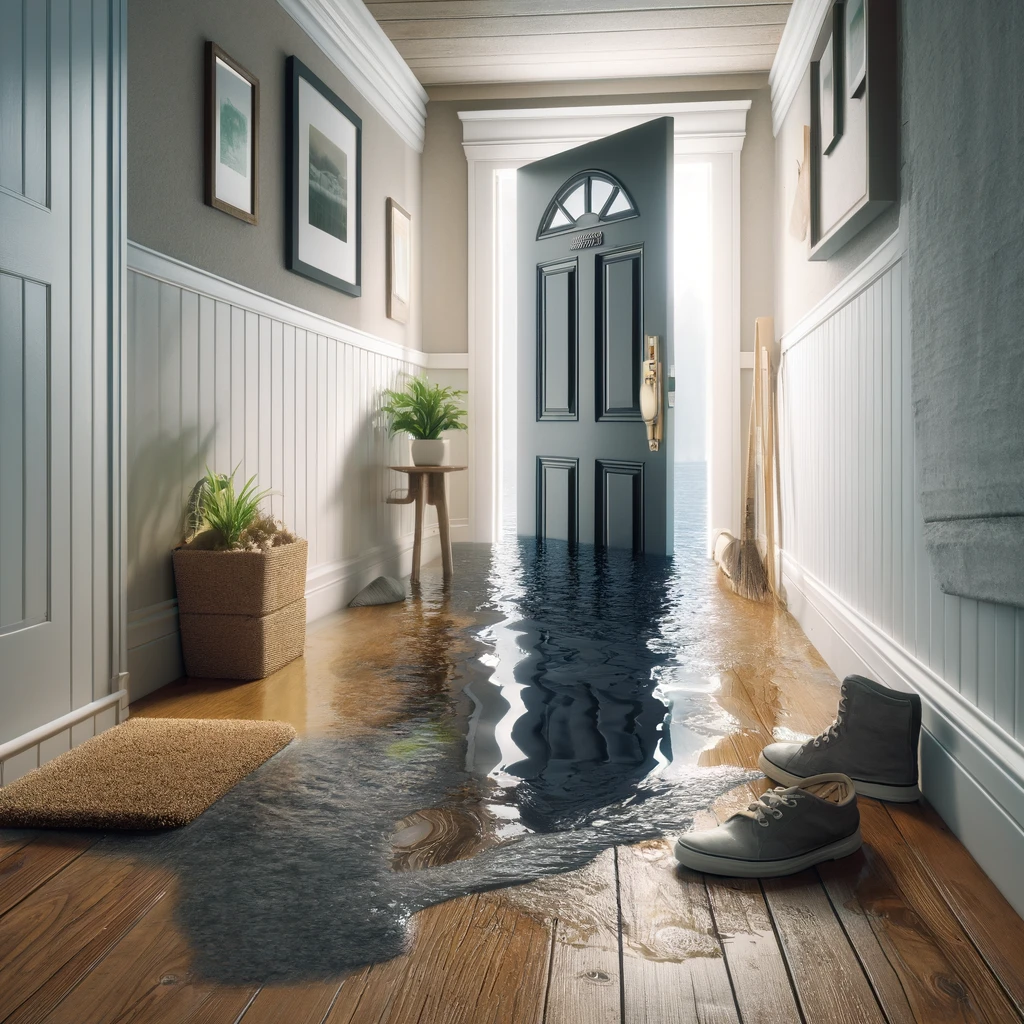
-
External flood
- Common sources of external flooding: natural disasters, heavy rain, river/creek overflows, fire hydrant or plumbing breakage at a neighboring property.
- Potential damage caused by external flood water:
- Water Damage: External flood water can inundate a home, causing severe damage to walls, floors, and belongings. This water often contains mud and debris, leading to additional cleanup challenges and damage.
- Structural Damage: The force and volume of flood water can stress structural elements of a building, including the foundation, walls, and floors. Prolonged exposure to flood water can result in significant weakening and deterioration of these structures.
- Contamination: Unlike clean water leaks, external flood water can carry soil, chemicals, sewage, and other hazardous substances, leading to contamination that requires specialized cleaning and potential health risks.
- Electrical Damage: Flood waters can reach electrical systems and appliances, posing serious risks of short circuits and electrical fires. Complete system checks and possibly extensive repairs may be necessary after exposure to flood water.
- Damage to HVAC Systems: Heating, ventilation, and air conditioning systems can be severely damaged by flood water, impacting ducts and mechanical components, which may require complete replacements.
- Mold and Mildew Growth: The high levels of moisture and organic materials brought in by flood water create ideal conditions for rapid mold and mildew growth, which can spread throughout a property and pose ongoing health and structural issues.
Water Leaks
- Common sources of water leaks: Pipe leaks, appliance malfunctions, exterior or roofing damage.
- Signs of water leaks: Damp walls, discolored drywall or ceiling, audible dripping noise, increased water bill.
- Potential damage caused by water leaks:
- Water Damage: Slow and persistent leaks can cause gradual damage that may go unnoticed until significant harm has occurred. This includes staining, swelling, and deterioration of walls, ceilings, and floors.
- Structural Damage: Over time, continuous water exposure can weaken structural components such as joists, beams, and foundational supports. This may lead to long-term stability issues and costly repairs.
- Mold and Mildew Growth: Water leaks create moist environments that are conducive to mold and mildew growth. These can spread within wall cavities and under flooring, posing health risks and potentially leading to extensive remediation needs.
- Electrical Damage: Leaks that infiltrate electrical systems can cause corrosion or short circuits, posing safety hazards and possibly leading to electrical failures or fires.
- Damage to Insulation: Insulation that becomes wet from leaks loses its thermal resistance properties. It also becomes heavier and may compress, which reduces its effectiveness and may require replacement.
- Plumbing Complications: Continuous leaks can also exacerbate wear on pipes and fittings, potentially leading to more extensive plumbing issues that require thorough repairs or replacements.
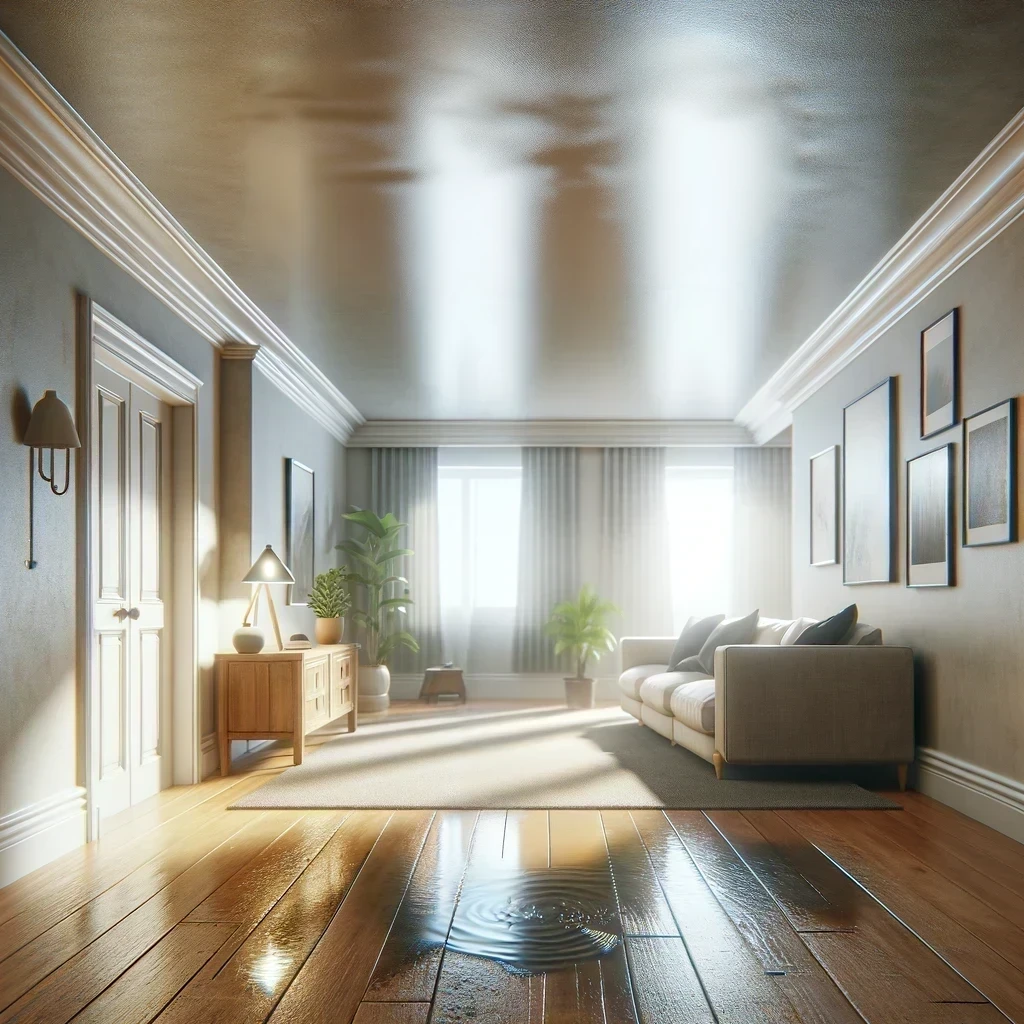
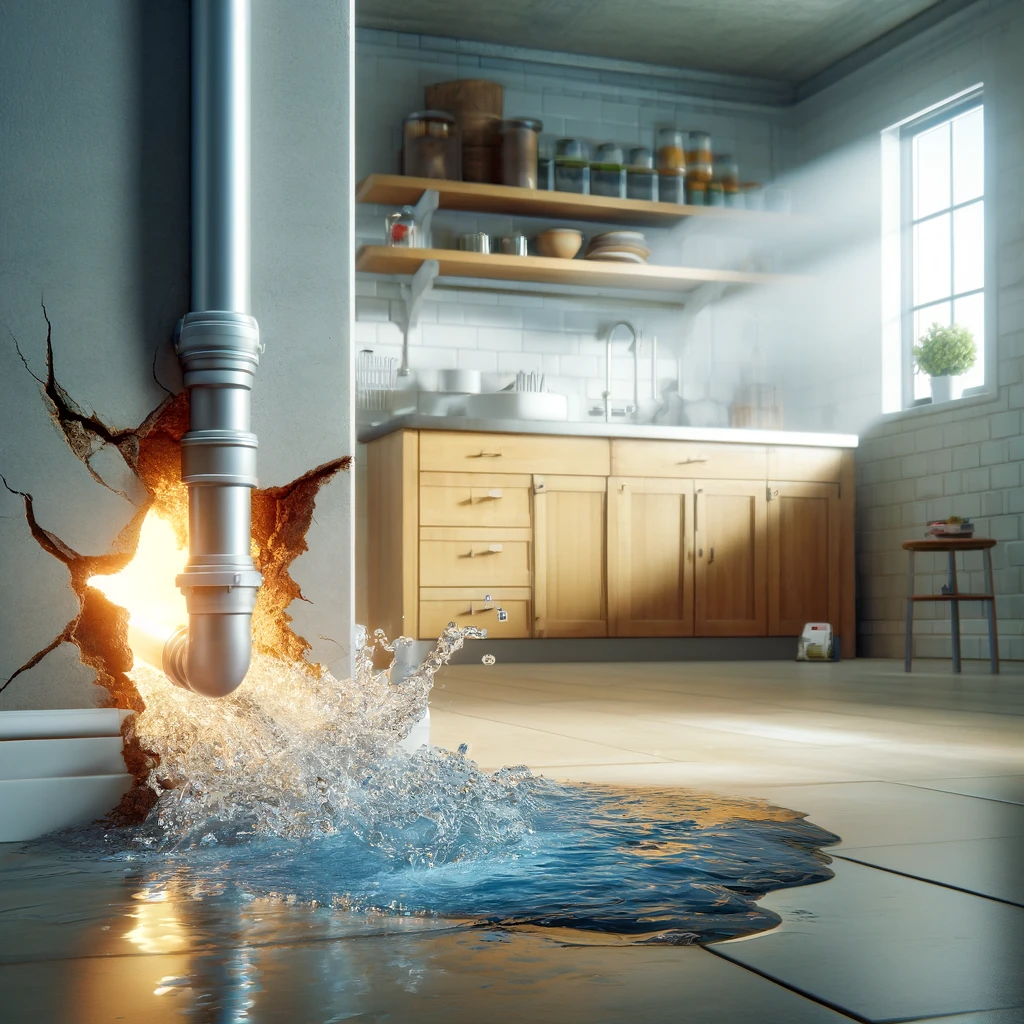
Burst Pipes
- Common causes of pipe bursts: Freezing temperatures, aging pipes
- Immediate actions to take: Close the shut-off valve if you know how to access it, and immediately call us or a plumber if you don’t. Shut off electrical to any area that might become affected, and take every care to avoid putting yourself at risk.
- Potential damage caused by a pipe burst:
- Water Damage: Water escaping from a burst pipe can quickly spread throughout the home, soaking floors, walls, and ceilings. This can lead to extensive damage to paint, wallpaper, and other finishes.
- Structural Damage: The force and volume of water from a burst pipe can compromise the structural integrity of building materials, such as wooden beams, studs, and even the foundation. Prolonged exposure to water can lead to rot and structural weakening.
- Mold and Mildew Growth: Burst pipes create damp conditions ideal for the rapid growth of mold and mildew, which can begin to form within just 24 hours. These fungi can be hazardous to health and difficult to eradicate.
- Electrical Damage: Water from burst pipes can infiltrate electrical systems, causing risks of shock, short circuits, and potential fires. This can also lead to costly repairs or replacements of electrical components and systems.
- Damage to Insulation: Water-soaked insulation loses its effectiveness and can also become a breeding ground for mold. Replacement of insulation may be necessary after a pipe burst to restore its thermal properties.
- Plumbing Complications: Aside from the initial burst, the pressure and damage to the plumbing system can lead to further issues such as leaks and decreased water pressure, which might require comprehensive plumbing repairs.
Hot Water Tank Bursts
- Warning signs: Rusty water, strange noises
- Potential damage caused by tank bursts:
- Water Damage: The most immediate impact of a hot water tank burst is water damage. If the tank is located inside your home, particularly in areas like a basement or utility closet, the sudden release of large volumes of water can flood those areas, damaging floors, walls, and any personal belongings or equipment stored there.
- Structural Damage: Over time, the water from a burst hot water tank can seep into structural components like joists and beams, leading to potential weakening of the structure. Sustained water exposure can cause wood to rot and metal to corrode.
- Mold and Mildew Growth: The damp conditions created by a burst hot water tank are ideal for mold and mildew to thrive. Mold can develop within 24 to 48 hours under the right conditions, posing health risks and further damaging building materials and personal items.
- Electrical Damage: If water from a burst reaches electrical systems, it can cause short circuits and potential fire hazards. It can also damage appliances and electrical equipment located nearby.
- Damage to Insulation and HVAC Systems: Water can saturate insulation, reducing its effectiveness and potentially damaging HVAC systems if the burst occurs nearby these installations.
- Plumbing Complications: A burst tank can cause immediate and subsequent damage to the plumbing system, especially if the burst leads to ongoing leaks or stresses on the piping and joints.
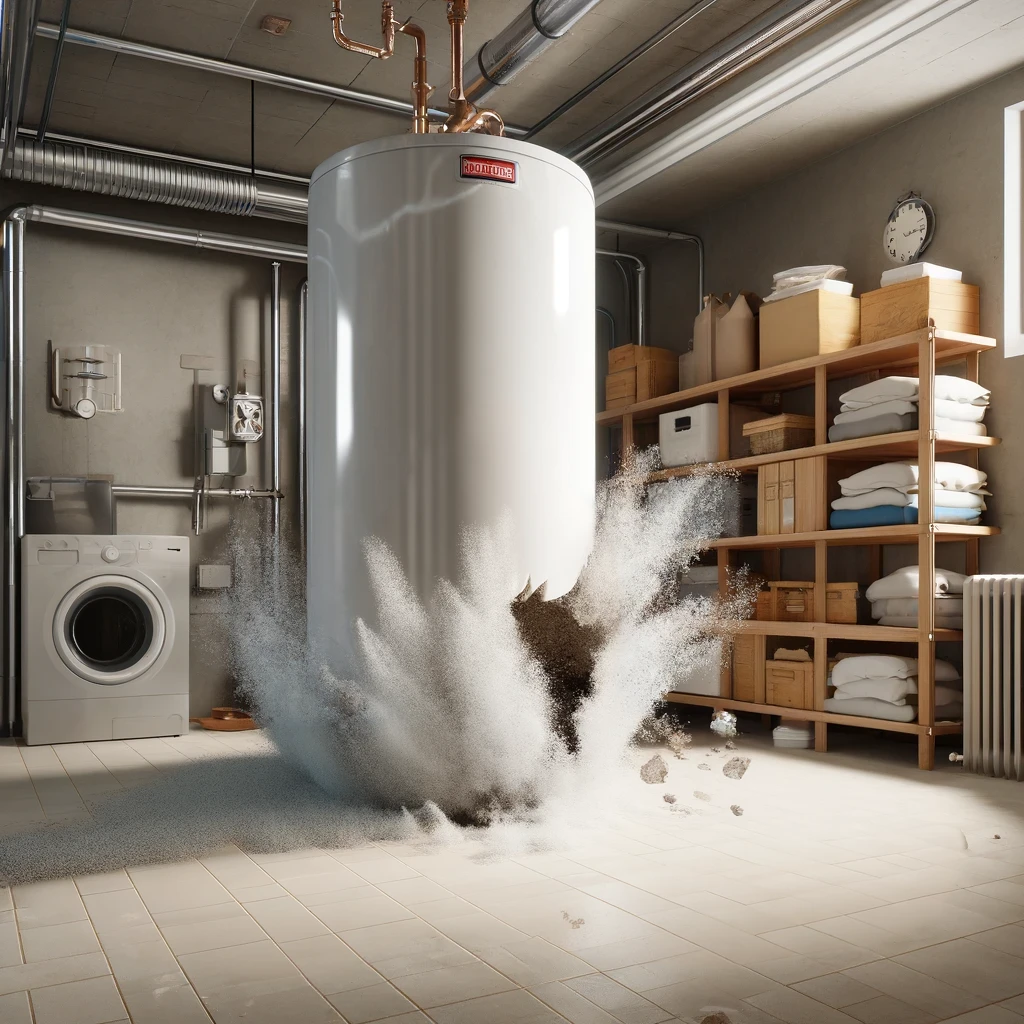
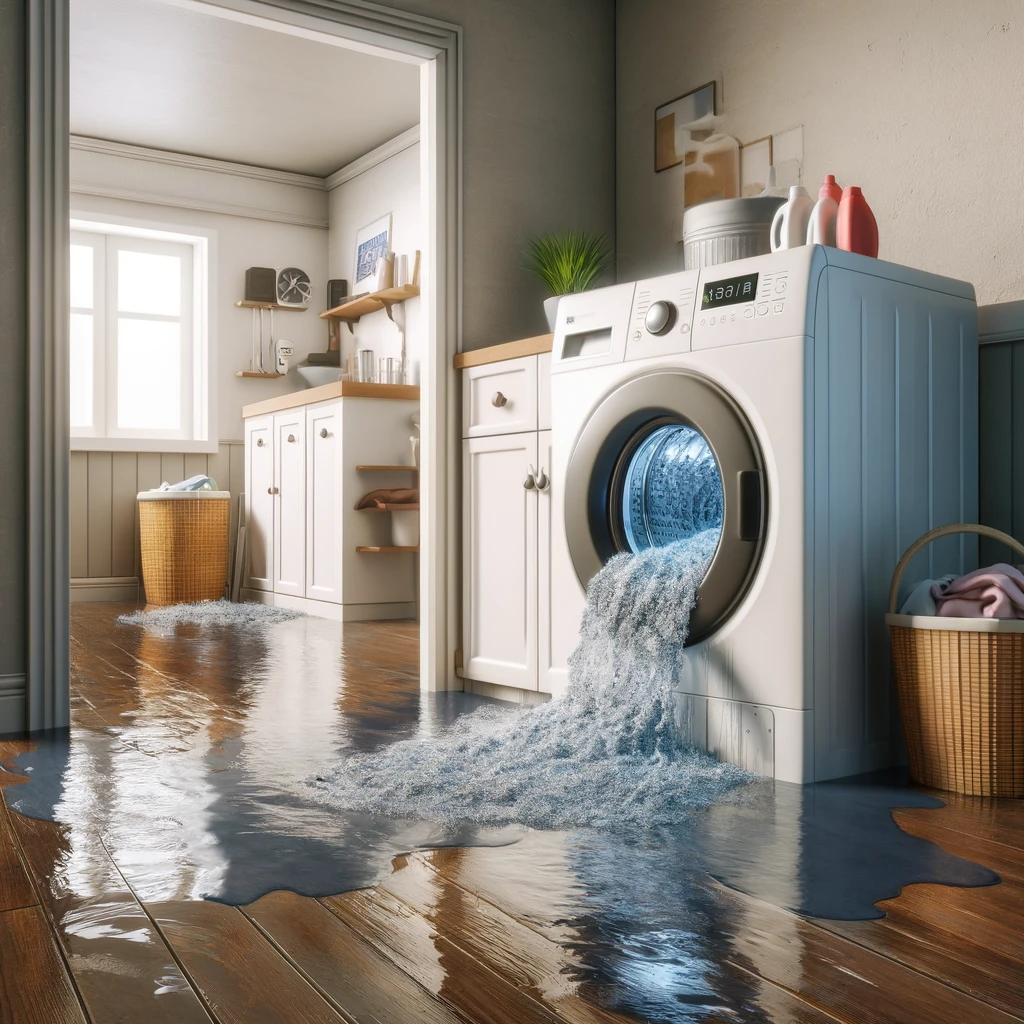
Washer Floods
- Causes: Hose malfunctions, overflows
- Potential damage caused by washer overflow:
- Water Damage: An overflow from the washing machine can lead to significant water damage, especially if it occurs in a laundry room or adjacent areas. This includes damage to flooring, walls, and any nearby items such as cabinetry or stored goods.
- Structural Damage: Prolonged exposure to water from a washer overflow can weaken structural components such as subflooring, wall framing, and foundational elements. This water can cause wood to swell, warp, or rot and can also lead to deterioration of drywall or plaster.
- Mold and Mildew Growth: The moist environment created by an overflowing washer provides perfect conditions for mold and mildew. These can develop quickly, presenting health risks and further damaging affected materials.
- Electrical Damage: Water from a washer overflow can reach electrical outlets, wiring, and appliances, posing risks of short circuits, malfunctions, and potential fire hazards.
- Damage to Flooring and Carpets: Flooring materials such as laminate, hardwood, or carpet can be particularly vulnerable to water damage. Carpets may need extensive cleaning or replacement, and hardwood floors can buckle or warp.
- Damage to Nearby Appliances and Furniture: If water spreads beyond the immediate area of the laundry room, it can damage other home appliances, furniture, and electronics that are not typically designed to withstand water exposure.
Water Damage Quick Tips:
DO…
- Contact a Restoration Professional: As soon as you notice water damage, immediately contact a certified restoration expert to assess and begin the restoration process.
- Safety First: Consider all water-impacted surfaces and furnishings as potentially contaminated. Keep children and pets out of affected areas until they have been properly decontaminated.
- Ventilate Affected Areas: To aid in drying:
- In summer, use air conditioners to help dry out wet areas.
- In winter, alternate between opening windows and using heating to promote drying without increasing humidity.
- Remove Standing Water: Use sponges and towels to blot and absorb standing water from flat surfaces, especially on wood and laminate flooring.
- Protect Your Floors:
- Remove saturated rugs and carpets to prevent damage to hardwood floors underneath.
- Place aluminum foil squares under furniture legs to prevent staining of carpets.
- Avoid Structural Dangers: Stay clear of rooms where ceilings are sagging from water retention to avoid injuries.
- Care for Electronics and Appliances:
- Move computers and other sensitive electronics to a dry environment. Remove cases and gently blow dry with low-pressure air.
- Remove lamps, telephones, and decorative items from wet furniture tops to prevent further damage.
- Aid Interior Drying: Open all cupboards and drawers to promote drying. Do not force open stuck drawers or doors, as this can cause further damage.
- Preserve Important Documents and Books: Freeze valuable books and documents in plastic bags to slow mildew growth until proper drying methods can be employed.
- Be Cautious with Cleanup:
- Wear gloves, masks, and boots during cleanup to protect against contaminants in water.
- Discard any food, including canned goods, that came into contact with flood water or wait for your restoration company to do this for you.
DO NOT…
- Do Not Operate Electrical Appliances: Avoid operating TVs, vacuums, or other appliances while standing on wet carpets or floors, especially wet concrete floors. Serious injury from electrocution may occur.
- Avoid Using Heat in Closed Interiors: Do not use heat to dry out closed building interiors as this can lead to mildew growth and exacerbate moisture damage.
- Handle Wet Fabrics Properly: Do not leave wet fabrics in place. Hang them apart to dry as soon as possible to prevent mold and mildew.
- Prevent Cross Contamination: Avoid tracking contaminated materials into undamaged areas of your home or building to stop the spread of contaminants.
- Be Cautious with Germicidal Products: Do not attempt to decontaminate surfaces solely with sprays or other germicidal products, as these may not fully disinfect contaminated surfaces. Professional cleaning products and methods are recommended.
- Do Not Use Your Home Vacuum for Water Removal: Home vacuums are not designed to handle water removal and could cause electrical shock or damage to the vacuum.
- Avoid Direct Contact with Contaminated Water: Do not touch or handle items that have been contaminated by flood water without proper protective gear, as this water may contain harmful bacteria and chemicals.
Okanagan Restoration Services is ready to help you begin the restoration process.
Advice and estimates are free.
For 24 Hour Emergency Response
South Okanagan Kelowna | Penticton | Osoyoos
103 - 2175 Optic Court Kelowna, BC V1V 0G5
North Okanagan Vernon | Salmon Arm | Revelstoke
6236 Pleasant Valley Rd Vernon, BC V1B 3R3